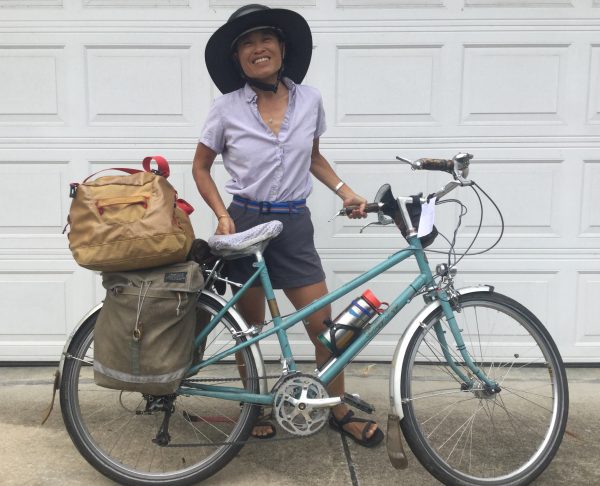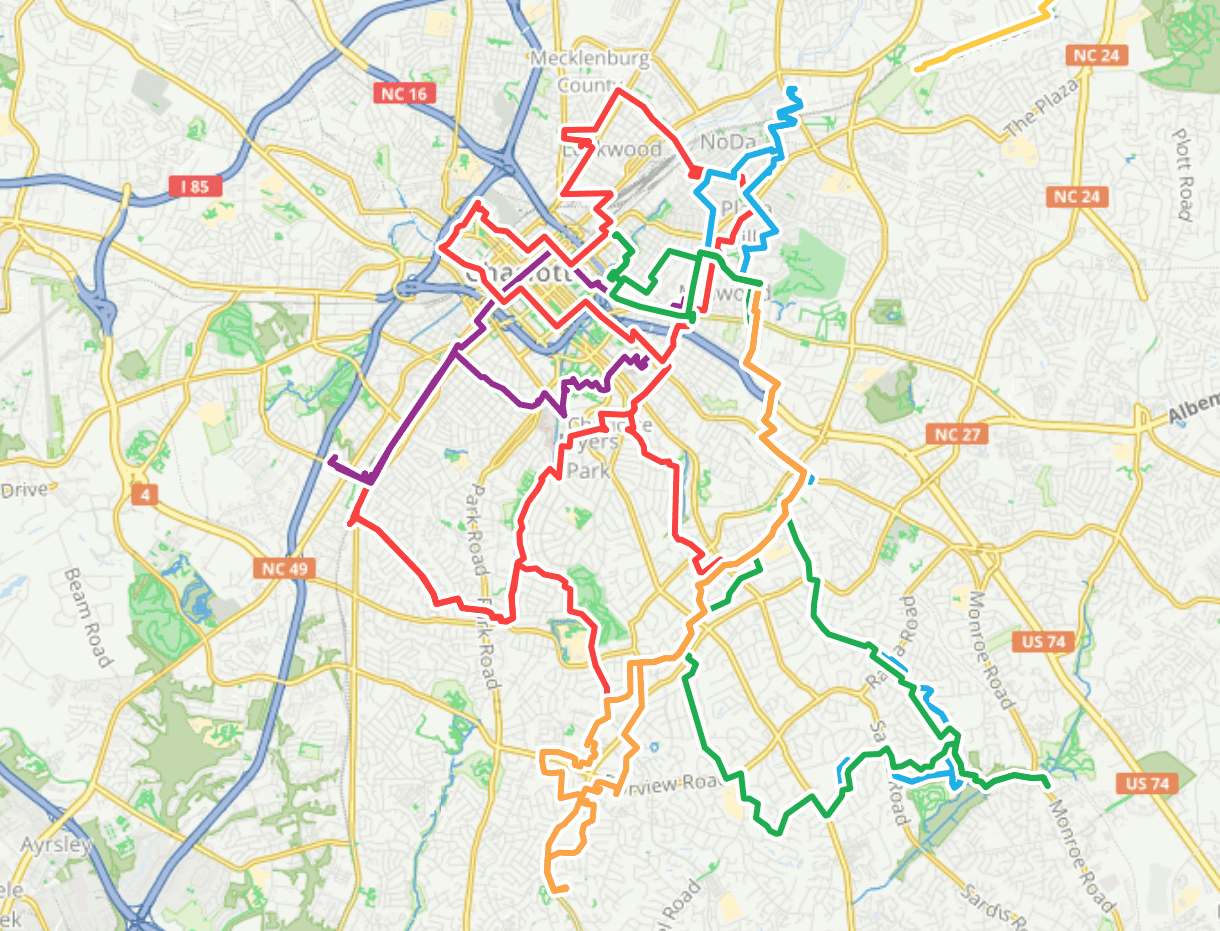Here’s how Pam Murray lives car-free in Charlotte

Pam Murray sees Charlotte through different eyes — and from a different seat — than most people as she moves about the city.
Murray, one of the biggest bicycle advocates in Charlotte, uses her bike for everything from getting groceries to hauling furniture. She bikes somewhere around 20 miles a day on average, only using her car occasionally to keep the battery charged.
Murray’s philosophy on riding goes beyond recreational opportunities or sticking to bike-only lanes and greenways. A ride with her involves getting to where you’re going, even if you have to hop on a main road like Providence or Randolph for a little while.
“The key thing is just to make sure people are not dependent on bike specific infrastructure, or greenways. I think that they’re great,” said Murray, who founded Charlotte Spokes People and runs Cycling Savvy workshops. “But you cannot get everywhere you need to go using only those things. You’re going to have to know how to use a travel lane eventually, or how to cross the street.”
But most of her routes involve connecting neighborhood streets. Below, you can see a map of Murray’s trips over the course of one recent week to get an idea of how she moves around the city (click to visit an interactive map).
As Charlotte invests more in bicycle infrastructure and tries to get more people out of their cars, the city is hoping more people will follow Murray’s lead and start pedaling instead of turning the key. Fewer than 1% of Charlotteans regularly commute by bike. But for that to work, more of us are going to have to take on some of Murray’s fearless attitude and learn her route-planning skills as well.
I can personally attest that a ride with Murray is an eye-opening experience — and not at all scary, if you’re worried about riding on main roads. Below are excerpts from a recent conversation I had with Murray about the future of biking in Charlotte, and what people need to know to take advantage of the whole city (not just greenways and protected bike lanes).
Listen to the whole podcast here.
Ely Portillo
Charlotte is usually described as an auto-dependent city. Do you need a car to get around Charlotte and live your life?
Pam Murray
Absolutely not.
Ely Portillo
Tell me why?
Pam Murray
Well, I’ve done it for over 10 years. I ride my bike daily to everywhere I need to go, or whatever I need to do. And I’d also add that I try to shop local to support the local economy. So when I do have to order something, because everything is not on the store shelves, you can order things for store pickup, so that you’re not inducing another trip to your house. So it’s more efficient for the distribution of the products that you’re ordering.
Ely Portillo
So I think that you’ve got a really different way of looking at the city. And you really see things in a way that most people don’t in Charlotte, and quite literally, that’s from the seat of your bike. How did you start doing this? And how did you realize, you know, hey, I don’t really have to drive my car every day.
Pam Murray
Okay, so the beginning was I bought bikes, my kids were learning to ride bikes. So, 2006. My kids were four and eight years old. And they were just now learning to ride bikes. So I went to the bike shop, we bought bikes for everybody, and taught them how to ride the bike at the local park on the basketball court. And then I started riding more and more for, you know, recreation to get them out of the house, you know, we rode to the park, basically, we wrote to Dairy Queen, we rode around the neighborhood. And then I basically just kept riding because it was fun, you know, and so it was exercise, there’s recreation as a family activity. You know, you’re out in the fresh air and you see so much. So many things that you can’t see otherwise, right when you’re driving your car.
Ely Portillo
You really see everywhere as the bike’s domain. Talk to me about your approach to riding and how you use the whole of our transportation network, and how you’re strategic about it too.
Pam Murray
Right, the way that I use the transportation network is through using everything available to bikes…There’s also multi-use paths, there are sidewalks that we can use, there’s connectors, and neighborhoods that connect one neighborhood to to the other, we can use greenways, we can use so many more things, paid parking lots to go through that we connect to get you off a busy road, for instance. So I use the entire network to my advantage. So you know, including traffic signals, signal timing, pedestrian crosswalks, pedestrian buttons, there’s all kinds of things that bikes can use. And that’s not even mentioning the bike-specific infrastructure, which is an additional thing that we have. And I know a lot of people, you know, that’s where their main focus is that, oh, we got to, you know, focus on that. But, you know, that’s a very small part of the entire transportation network that we just mentioned. So if you look at it as a percentage, I mean, it’s gonna be, you know, less than 1%, or whatever it is, if you do it by miles traveled, or lane miles or whatever type of metric you want to use. So, you know, you have to look at it as an entire system that you can use to your advantage when you’re riding a bike.
Ely Portillo
So we’ve gone riding together a few times, and I always start out being kind of scared of the times we have to jump on a larger road like Providence for a little while, before we can get back on to neighborhood streets. And then after going with you, I kind of realize, Oh, that’s not scary at all, if you’re smart about it, right. Tell me about how you approach those times you have to get on a larger road and maybe what people think of, or what people are thinking incorrectly about, because most people, if you tell them, Oh, I went riding, and we had to jump on Providence for a bit, and then we got on Sardis for a bit, they’re like, whoa, you did something death-defying.
Pam Murray
They’re like, I would never ride a bike on those roads. You know, I ride on all the roads. And so here in Charlotte, people are like, oh, you can’t ride on Monroe, or Freedom, Wilkinson, or whatever it is. I mean, I’ve written on all those roads to get where I go. But you know, just as you’ve observed — and this is why I insist on people riding before they make a statement, because they need to make the statement from experience, not from perception — they’re stating the perception from the seat of a car behind the steering wheel, because that’s all they know. Okay? So their perception is that they’re going to be in the platoon of cars, because that’s where they are. In reality, when I’m riding my bike, I’m in the gap of all the motorized vehicle traffic, so I’m not in the thick of traffic, I’m basically on an empty road, because I understand how signal timing works. And we talk about that in our cycling savvy class. I’m very strategic in terms of my route planning. So I’m using low volume, low speeds, streets, to make it very comfortable for anybody to ride. I’m like everybody else, I don’t want to be on a road where people are speeding, and they’re going fast, and the road’s not wide enough to share. And I’m getting passed close, I don’t want that. Like anybody else. But I will get to where I’m going. And you know, I’ve taken you on rides, and we’ve gone on, you know, Highway 51 and Providence and Sardis. And whatever it was wherever we needed to go. And that’s key. That’s why when I do a bike ride, I like to take people to destinations or businesses because you know what, that’s where businesses are, they’re located on roads, they have to locate there. They’re not going to stay in business if nobody can find them.
Ely Portillo
Tell me about some of the most common misperceptions that you encounter when you’re teaching people about riding in Charlotte. What are the reasons you hear when people say, oh, you know, I can’t do that. That’s not a practical way for me to get around. Maybe it’s a fun thing to do on the weekends. And what do you tell people?
Pam Murray
Well, they feel like they’re going to be run off the road, people are going to be yelling around them all the time, they’re going to be honking their horns at them all the time. And, I mean, we’ve done several miles together. And, you know, I’ll ask you how many times we don’t believe those things happen to you? Yes, zero. They don’t happen to me on a regular basis. They do happen occasionally. But you know, when that happens, I feel like that’s gonna happen, regardless of whether I’m riding my bike or driving my car. That person in the car is having a bad day, and I can’t help that, you know, it doesn’t matter how I’m choosing to operate in the travel lane. I could be a pedestrian, they could be honking at me, you know. So that’s not my problem. And I don’t generally have that issue on a regular basis. And, you know, I lead a lot of bike rides around and people ride with me, and they’ll tell you, that’s not the experience that we generally have. But I will say it does happen occasionally. And I would counter that it happens to you when you drive your car too, you know.
Hear the Full Conversation:
